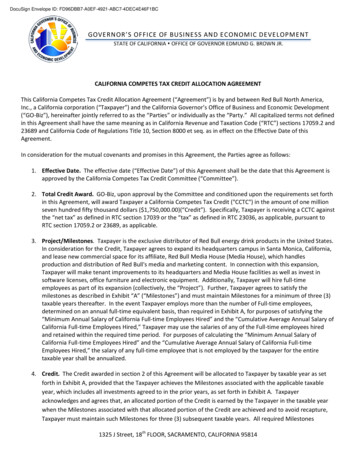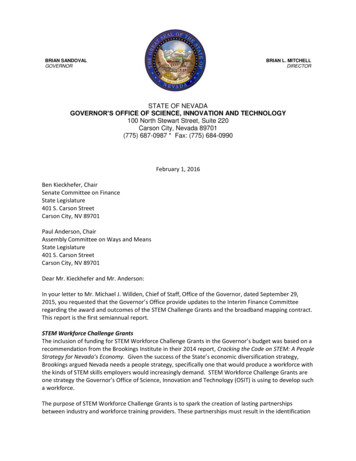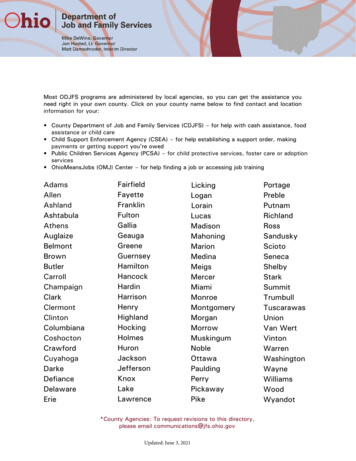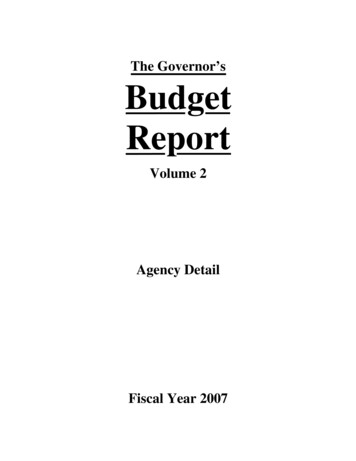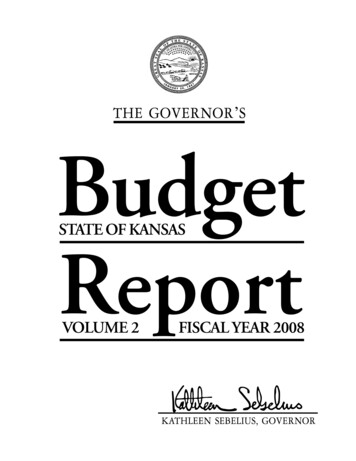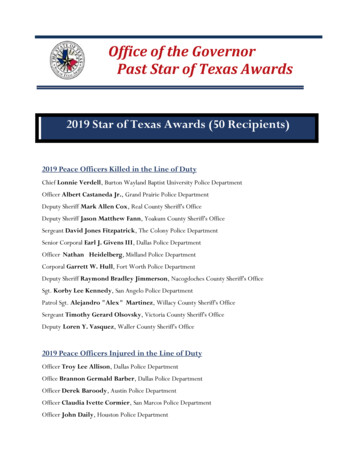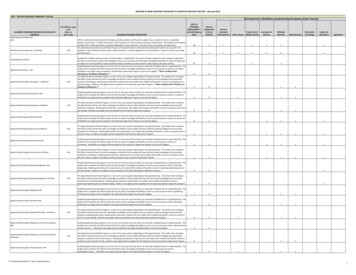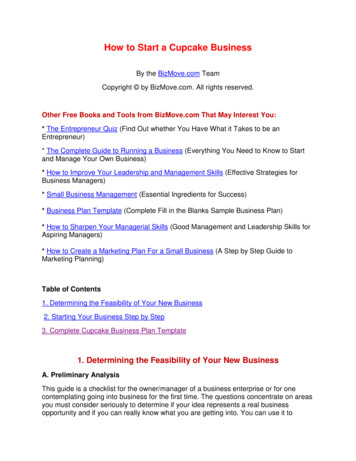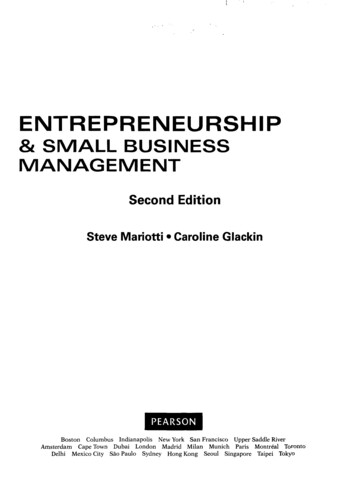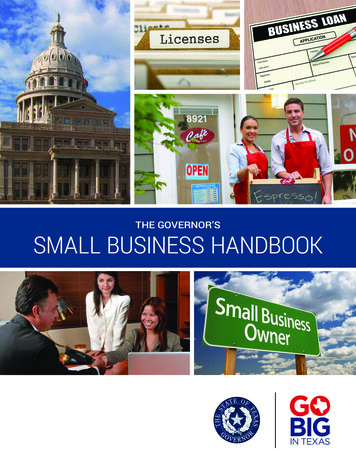
Transcription
THE GOVERNOR’SSMALL BUSINESS HANDBOOK
DisclaimerThis handbook is intended to provide general guidance and assistance to those interestedin developing or further expanding their business in Texas and beyond. It is not intendedto be construed or relied upon as legal, accounting, or other professional services oradvice. Every effort has been made to make this publication as complete as possible,but by no means can all subject matters, rules, regulations, and resources involved incommerce be covered in one document. Please be aware that the information containedherein is subject to change without notice. If uncertain as to how to proceed on anygiven matter, legal or other professional services should be sought.This handbook was created with substantial assistance from many resources outsideand inside the Office of the Governor. Every effort was made to accurately source thesetools and other tools that are available to small businesses in Texas. For additionalcopies of this handbook, or for additional information on any of the topics covered,please call 512-936-0100.Contact usThe Governor’s Office of Economic Development and TourismP.O. Box 12428Austin, Texas 78711-2428Telephone: 512-936-0100Fax: vernor.state.tx.us2 GOVERNOR’S SMALL BUSINESS HANDBOOK INTRODUCTION
Table of ContentsPage4A Letter from the Small Business Team5Preparation: Writing a Business Plan7How to Start a Business in Texas: Overview and Registration8Business Entity Formation & Registration18Guide to Status Terminology Used by the Secretary of State21Business Filings and Trademarks Fee Schedule26Tax Responsibilities28Licenses, Permits, and Employer Requirements30Insurance Requirements37Texas Workforce Commission: Business Solution Programs39Unemployment Tax41Small Business Development Centers46Veterans Resources54Financing: Overview & Lenders73Financing: State Programs76Financing: Local Incentives78Financing: Federal Programs & Grants86Interesting Facts About the Texas Economy and Small Business89Texas Procurement and Support Services (TPASS)90State of Texas HUB Certification and Eligibility92Small Business Certifications (SBE/DBE/WBE): Program Overview98Index: State Business Licenses and Permits by Business Type124Index: Federal and State Agency Contact InformationINTRODUCTION GOVERN OR’ S SM ALL BUSINESS H A NDB O O K 3
Letter from the Small Business TeamSmall businesses are an important part of the state’s mission in helping keep Texasa very business-friendly, fair, dynamic and flourishing economy — one of the best,healthiest and fastest-growing in the country. Small businesses are the backbone ofour state and nation, and through collaborations with organizations like yours we helpensure that they remain a top priority and focal point of the public and private sector.We hope that this handbook will provide a resourceful foundation, inspire new ideas andexpanded connections, and encourage the inception, growth and prosperity of smallbusinesses in and around your community.This handbook has been compiled to provide business owners and entrepreneurs withthe information and knowledge necessary to start or grow a small business in Texas.It contains information from various state agencies to give you a straightforwardapproach to your new or existing business. From registering your business to obtainingyour HUB certification, this resource has been produced to demystify the process ofdoing business in Texas.In addition to utilizing this information, consider attending a Governor’s Small BusinessForum. With more than 20 forums across the state, the Governor’s Small BusinessForums are instrumental in providing information to businesses in the region. Theseevents offer information on financing, social media, government contracting, incentiveson hiring veterans, and many more facets of business.On behalf of the Governor’s Office, we wish you continued success in all of your endeavorsand your enterprises.Best wishes,The Governor’s Small Business Team4 GOVERNOR’S SMALL BUSINESS HANDBOOK INTRODUCTION
PREPARATION: Writing a Business PlanCreating a comprehensive business plan is an important process. The idea of writing a business plan may not seem important, however, it ultimately serves many important purposes. Itwill serve to outline the main purpose of your business, its structure, its financing, and its advantages over other market competitors. A solid business plan can be used as a frameworkfor your company’s mission and serves as support when it comes time to apply for financing.Here are some notes about what can be included in a Business Plan:Business NameExecutive Summary: Description of the product or service that your company will sell; towhom the product or service will be sold to; how much this will cost; and how long it will taketo become profitable. Keep it simple.Business set-up and structure: Description of the company’s business, legal, and leadershipstructure. Follow this by a discussion of the company’s management approach, hiring process, office and equipment needs. Include a list of the necessary licenses and permits thatwill be obtained.Strategic Financial Plan: Outline of how much money the business will need and where thesupport will come from. Include a breakdown of the monthly budget and cash flow for thefirst year. Include detailed information on the current market and projected customer demands; pricing strategy; available financial support; anticipated financial support; costs associated with development, production, office space, employee salaries, equipment purchase,etc.; anticipated timeline for marketing; goals for profitability. *If your business is seeking financing then you will probably be asked to provide income statements demonstrating soundfinancial accountability. Provide a stated goal for when the company will be profitable andwhat the return on the investment will be.Development and regulatory process outline: Provide a time frame demonstrating the timeit will take to build, produce, and generate the business. Include breakdown of any risk andexplain why and how that will be overcome.INTRODUCTION GOVERN OR’ S SM ALL BUSINESS H A NDB O O K 5
Marketing Plan: Provide information regarding the ideal customer; how the ideal customerwill be reached; and when this will occur. Provide information on the pricing strategy andwhy consumers will buy the product or service. Provide an overview of how marketing andoutreach will serve to promote your business so that consumers become a reality. Explainhow the product will be marketed so to demonstrate a competitive edge over the other similarproduct or service providers in the industry. Explain the expenses involved in marketing theproduct and services.Biographies of all of the people on the team that demonstrates their education, experience,skills, and expertise are in line with the business’s mission.Launch and delivery plan: Discuss where the business is going. Inform readers of how investors will get money out of the business, and what the rate of return on the investment willeventually look like. Include discussion of whether the company could eventually be takenpublic, and what would be at risk.6 GOVERNOR’S SMALL BUSINESS HANDBOOK INTRODUCTION
How to Start a Business in TexasIn business, there are no guarantees. There is simply no way to eliminate all the risksassociated with starting a small business but you can improve your chances of successwith good planning, preparation, and insight. In Texas, small businesses continue tothrive due to a variety of factors including our excellent geographic location, our highlyskilled workforce, our low tax burden, our reasonable cost of living, our predictableregulatory environment, and our legacy of being Wide Open for Business.Starting a business in Texas requires you to complete a number of basic steps and makesome key decisions. As part of your overall plan, you’ll need to select a location, decideon a business structure, obtain the necessary licenses and permits, and determinewhich financing options will meet your needs and goals.The following steps are a basic process for starting a new business. Additional formsand information are provided in the index. Please note that new business owners shouldnot hesitate to seek the guidance of a professional tax consultant, accountant, and/orattorney to help verify that all legal requirements are met before operating a business.Step 1: Business Structure and NameDetermine the legal structure of the business and properly file the business name withthe state and/or county.Step 2: Tax ResponsibilitiesDetermine the potential tax responsibilities of the new business on the federal, state,and local level.Step 3: Business Licenses and PermitsDetermine necessary licenses, permits, certifications, registrations, and/or authorizations for a specific business on the federal, state, and local level.Step 4: Business Employer RequirementsDetermine federal and state employer requirements. There are various laws relating toemployment of personnel.INTRODUCTION GOVERN OR’ S SM ALL BUSINESS H A NDB O O K 7
STEP ONE: Business Entity Formation and RegistrationSELECTING A BUSINESS ENTITY FORMATION AND REGISTERING WITH THE TEXASSECRETARY OF STATE (if necessary): Determining which business structure is rightfor a business is an important decision. The information in this section provides anoverview of the most commonly utilized for-profit business structures. (Disclaimer: Forthe most current and accurate information on business entity formations, contact theTexas Secretary of State).SOLE PROPRIETORSHIP: A sole proprietorship is the most common and simplest formof business structure. A sole proprietorship exists when a single individual who ownsall of the business’s assets engages in business activity without the necessity of havingto have a formal organization.A sole proprietor is personally liable for all debts and liabilities. Under a sole proprietorship,there are no legal distinctions between personal debts and business debts, and thereis no requirement to file a separate federal income tax return. Business ownership isnontransferable in that an individual cannot transfer his tax identification number toanother person or entity- a new tax identification number will be required. For similarreasons, the life of the business is limited to the life of the sole proprietor.A sole proprietorship is often operated under the name of the owner. If a sole proprietorshipconducts business under a name other than the surname of the individual owner, thenit is necessary to file an “Assumed Name Certificate” (commonly referred to as a “DBAcertificate”) with the office of the county clerk where a business premises is maintained.If no business premise is maintained, then an assumed name certificate should be filedin all counties where business is conducted under the assumed name. More informationavailable on registration of an assumed name certificate with your local county clerk’soffice in the following pages.Sole proprietorships are not subject to state franchise tax. 1FOR PROFIT CORPORATION: A corporation is a legal person with the characteristicsof limited liability, centralization of management, perpetual duration, and easeof transferability of ownership interests. The owners of a corporation are called“shareholders.”1Unless single member LLC is filing as a sole proprietor for federal income tax purposes.8 GOVERNOR’S SMALL BUSINESS HANDBOOK STEP ONE
The persons who manage the business and affairs of a corporation are called “directors”.1A For-Profit Corporation must register with the Texas Secretary of State.Choosing the best management structure for your corporation, should you pursue thisformation, is a decision you should make under the advisement of an attorney. Pleasenote that what is referred to as an “S” corporation is not a matter of state corporate law,but rather a federal tax election. A for-profit corporation elects to be taxed as an “S”corporation by filing for this status with the Internal Revenue Service. Please contactthe IRS and/or competent tax counsel regarding the decision to elect to file as an “S”corporation for federal tax purposes. This is not a matter that is handled by the TexasGovernor’s Office.2Corporations are subject to a state franchise tax. The filing fee for a certificate offormation for a for-profit corporation is 300.PROFESSIONAL CORPORATION: A professional corporation is a corporation that isformed for the purpose of providing a professional service, which a typical corporationis prohibited from rendering by law. A “professional service” means any type of servicethat requires, as a condition precedent to the rendering of the service, the obtaining of alicense in this state, as well as registration with the Texas Secretary of State.3Only a professional individual licensed to practice the same professional service as isprovided by the professional corporation may be a governing person or managerial officialof a professional corporation. Also note that a professional corporation cannot be formedfor the practice of medicine.4 If the purpose of the entity is to provide medical services, theprofessional may form either a professional association or a professional limited liabilitycompany.Professional corporations are subject to a state franchise tax. The filing fee for aprofessional corporation is 300.PROFESSIONAL ASSOCIATION: A professional association is a professional entityformed for the purpose of providing professional services rendered by a doctor of1However, state corporate law does provide for shareholders to enter into shareholders’ agreements to eliminate the directors and providefor shareholder management.2A for-profit corporation is governed by titles 1 and 2 of the Texas Business Organizations Code. Title 1, chapter 3, subchapter A, ofthe Texas Business Organizations Code governs the formation of a for-profit corporation and sets forth the provisions required or permitted to becontained in the certificate of formation.3A professional corporation is governed by title 1, Chapters 20 and 21 of Title 2, and Chapters 301 and 303 of Title 7 of the TexasBusiness Organizations Code. Title 1, Chapter 3, Subchapter A of the Texas Business Organizations Code governs the formation of a professionalcorporation and sets forth the provisions required or permitted to be contained in the certificate of formation. Title 7, chapter 301 establishes certainrestrictions and requirements regarding ownership and management of a professional corporation.4Texas Business Organizations Code § 301.003(3)STEP ONE GOVERN OR’ S SM ALL BUSINESS H A NDB O O K 9
medicine, doctor of osteopathy, doctor of podiatry, dentist, chiropractor, optometrist,therapeutic optometrist, veterinarian, or licensed mental health professional.2 Onlya professional individual licensed to practice the same professional service as theprofessional association may be a governing person, managerial official, owner, ormember of a professional association. Only a governing person of the professionalassociation may serve as the president of the association. A professional associationmust register with the Texas Secretary of State.Professional associations are subject to a state franchise tax.GENERAL PARTNERSHIP: A general partnership exists when two or more individuals orbusinesses associate for purposes of carrying on a business for profit. Under a generalpartnership, a separate business entity exists, but creditors can still look to the partners’personal assets for satisfaction of debts. General partners share equally in assetsand liabilities. A general partnership requires an annual partnership income tax returnbe filed (separate from the partners’ personal returns). Generally speaking, a GeneralPartnership operates pursuant to the terms of a partnership agreement. However,there is no requirement that the agreement be in writing in order to be recognizable.Nor is there a state filing requirement for General Partnerships. If the business of thepartnership is conducted under an assumed name (a name that does not include thesurname of all of the partners), then an assumed name certificate (commonly referredto as a DBA) should be filed with the office of the county clerk in the county where abusiness premise is maintained. If no business premise is maintained, then an assumedname certificate should be filed in all counties where business is conducted under theassumed name. General partnerships directly and solely owned by natural persons arenot subject to state franchise tax.LIMITED PARTNERSHIP: A limited partnership is a partnership that involves partnersthat do not have the obligations or duties of general partners by reason of being limitedpartners. In a limited partnership, there will be one or more general partners and one ormore limited partners. Partners may be individuals, partnerships, corporations, and anyother type of legal entity.2 To form a limited partnership, the partners must enter intoa partnership agreement and file a certificate of formation with the Texas Secretary ofState.1Texas Business Organizations Code § 301.003(3)2A professional association is governed by title 1, title 2, chapters 20 and 21, and title 7, chapters 301 and 302 of the Texas Business Organizations Code. Title 1, chapter 3, subchapter A of the Texas Business Organizations Code governs the formation of a professional association and setsforth the provisions required or permitted to be contained in the certificate of formation. A “licensed mental health professional” means a person,other than a physician, who is licensed by the state to engage in the practice of psychology or psychiatric nursing or to provide professional therapyor counseling services.10 GOVERNOR’S SMALL BUSINESS HANDBOOK STEP ONE
Limited partnerships are subject to state franchise tax. The filing fee for a certificate offormation for an LP is 750.LIMITED LIABILITY PARTNERSHIP: A registered limited liability partnership is a generalpartnership that has been registered with the Texas Secretary of State. A partner’s liabilityin a registered limited liability partnership differs from that of an ordinary partnership. Ina registered limited liability partnership, a partner is not individually liable, under somecircumstances, for debts and obligations of the partnership arising from errors, omissions,negligence, incompetence, or malfeasance committed in the course of business by othersin the partnership, while the partnership is a limited liability partnership.The registration of a partnership as a limited liability partnership is effective until thefirst anniversary of the date of registration or the later effective date specified in theapplication, unless the application is withdrawn or revoked at an earlier time or renewedbefore expiration. As mentioned previously, registration of a Limited Liability Partnershipwith the Texas Secretary of State’s Office is necessary. Limited Liability Partnershipsare subject to state franchise tax.The filing fee for a certificate of formation for a limited liability partnership is 200 pergeneral partner.LIMITED LIABILITY COMPANY: A limited liability company is created by filing a certificateof formation with the Texas Secretary of State. The Secretary of State provides a formthat meets minimum state law requirements.The limited liability company (LLC) is neither a corporation nor a partnership; rather, itis a distinct type of entity. It is an unincorporated business entity which shares someof the aspects of Subchapter S Corporations and limited partnerships, but has moreflexibility than more traditional business entities.The owners of an LLC are called “members.” An LLC may have one or more members.A member can be an individual, partnership, trust, and any other legal entity. Unlike thepartnership, where the key element is the individual, the essence of an LLC is the entity,which requires more formal requirements in terms of registration.The limited liability company is designed to provide its owners with limited liability1A limited partnership is governed by title 4, chapters 151 and 153 of the Texas Business Organizations Code. Title 1, chapter 3, subchapterA of the Texas Business Organizations Code governs the formation of an LP and sets forth the provisions required or permitted to be contained in thecertificate of formation.STEP ONE GOVERN OR’ S SM ALL BUSINESS H AN DB O O K 1 1
and pass-through tax advantages without the restrictions imposed on Subchapter SCorporations and limited partnerships.Generally, the liability of the members is limited to their investment and they may enjoythe pass-through tax treatment afforded to partners in a partnership. As a result of federaltax classification rules, and LLC can achieve both structural flexibility and favorable taxtreatment. Nevertheless, persons contemplating forming an LLC should consult with anattorney as to whether this structure is suitable for their business needs.1LLCs are subject to state franchise tax. Filing fee for a certification of formation for anLLC is 300The Texas Secretary of State OnLine Access (SOSDirect) web access system provides subscribers with up-to-date, on-line computer access to a variety of information maintained by theOffice of the Secretary of State. For more information, please see www.sos.state.tx.us/.1An LLC is governed by title 3, chapter 101 of the Texas Business Organizations Code. Title 1, chapter 3, subchapter A of the Texas Business OrganizationsCode governs the formation of an LLC and sets forth the provisions required or permitted to be contained in the certificate of formation.12 GOVERNOR’S SMALL BUSINESS HANDBOOK STEP ONE
FOREIGN OR OUT-OF-STATE ENTITIES: If an organization was formed under, andthe internal affairs are governed by, the laws of a jurisdiction other than Texas, theorganization is a foreign entity (business).The Texas Business Organizations Code (BOC) requires the following types of foreignentities to file an application for registration with the Texas Secretary of State in order to“transact business” in Texas:CorporationsLimited partnershipsLimited liability partnershipsLimited liability companiesBusiness trustsReal estate investment trustsCooperativesPublic or private limited companiesAny other foreign entity that, if formed in Texas, would be formed as a corporation,limited partnership, limited liability company, professional association,cooperative, or real estate investment trust; andAny other foreign entity that affords limited liability under the law of its jurisdictionof formation for any owner or member.Other laws or circumstances may also be reasons for registration. Texas statutes donot define “transacting business.” Helpful resources to determine whether an entity’sactivities in Texas require registration include: BOC § 9.251, which lists activities that arenot considered transacting business; Case law from Texas and other U.S. jurisdictionsregarding foreign qualification; Texas Attorney General Opinions; and Private attorneysfamiliar with corporate law.Failure to register can result in penalties, including: Inability to maintain an action, suit,or proceeding in a Texas court until registration; Injunction from transacting business inTexas; Civil penalty equal to all fees and taxes that would have been imposed if the entityhad registered when first required; and Late filing fees owed to the Secretary of State byan entity registering more than 90 days after first transacting business in Texas.REGISTERED AGENT: The Texas Business Organizations Code (“BOC”) requires everydomestic or foreign filing entity (business) to maintain a registered agent and office inTexas. A registered agent is an agent of the entity on whom may be served any process,notice, or demand required or permitted by law to be served on the entity.STEP ONE GOVERN OR’ S SM ALL BUSINESS H AN DB O O K 1 3
Generally, an individual Texas resident or an organization that is registered or authorizedto do business in Texas with a business office at the same address as the entity’sregistered office may consent to serve as the registered agent. Although an officer,owner, or employee may serve as an entity’s registered agent, an entity may not serve asits own registered agent. If your entity is not able to provide its own registered agent andoffice, some businesses, known as service companies, provide registered agent servicesfor a fee. Your attorney or accountant may also offer this service. The BOC requires thatregistered agents designated on or after January 1, 2010 must have consented to servein that capacity in a written or electronic form developed by the Office of the Secretaryof State.An entity’s registered office must be a physical address in Texas where the registeredagent can be served with process during business hours. The registered office is alsowhere the Secretary of State will mail correspondence. A registered office is the businessoffice address of the registered agent and may be the same as the entity’s place ofbusiness. It cannot, however, be solely a post office box that is part of a commercial mailor message service unless that commercial enterprise is the registered agent.A domestic or foreign filing entity is required to continuously maintain a registered agentand registered office in Texas. Failure to do so may result in the involuntary terminationof a domestic filing entity or in the revocation of a foreign filing entity’s registration.Therefore, it is important that an entity file a statement of change of registered agentand/or registered office with the Secretary of State to keep the name of the registeredagent and the registered office address current.BUSINESS NAME: The business name selected is the key identifying and marketingcomponent of the business. It should be given much thought and consideration. Adomestic or foreign corporation, limited liability company, limited partnership, limitedliability partnership, or other foreign filing entity that regularly conducts business orrenders a professional service in this state under a name other than its legal name(name stated in its certificate of formation or comparable document) must file anAssumed Name Certificate with the Secretary of State and with the county clerk in thecounty where a business premises is maintained (*note: assumed name certifies filedwith the county clerk must be sent directly to the appropriate county clerk and must benotarized and contain original signatures. There is more information on that process inthe subsection immediately below).An Assumed Name Certificate is necessary in order to give notice to the public that14 GOVERNOR’S SMALL BUSINESS HANDBOOK STEP ONE
the entity is conducting business under that name. If, under the Texas BusinessOrganizational Code, the name chosen is the same as or deceptively similar to, or similarto the name of any existing domestic or foreign filing entity, or any name reservation orregistration filed with the secretary of state, the document cannot be filed. If you wishthe secretary of state to provide a preliminary determination on name availability, youmay call 512-463-5555, dial 7-1-1 for relay services.Or, you may email your name inquiry to corpinfo@sos.state.tx.us. A final determinationcannot be made until the document is received and processed by the secretary of state.Do not make financial expenditures or execute documents based on a preliminaryclearance. Also note that the preclearance of a name or the issuance of a certificate offormation under a name does not authorize the use of a name in violation of anotherperson’s rights to the name. For more information on reserving or registering a nameunder the Texas Business Organizations Code, please visit the Texas Secretary ofState’s website at the following address: http://www.sos.state.tx.us/corp/forms boc.shtml#rrn.ASSUMED NAME CERTIFICATE FILINGS AND LOCAL REGISTRATION: If a businessoperates as a sole proprietorship or a general partnership, an Assumed Name Certificate(or a “DBA” form-doing business as) for each name1 that a business will use must be onfile with the county clerk in each county where a business premise will be maintained. Ifno business premise will be maintained, it should be filed in each county where businesswill be conducted.Corporations, limited partnerships, or limited liability companies identified by a nameother than the name on file with the Secretary of State, must file an Assumed NameCertificate with the Secretary of State and each county in which the business will havea registered or principal office. As mentioned above, please note that neither the filingof an Assumed Name Certificate nor the reservation or registration of a company nameimparts any real protection to the party filing the certificate. It is merely a formal processthat informs the general public of the registered agent for a business and where officialcontact with the business can be made. For more information on this process, or toview a form that can be used for this process, please visit the Texas Secretary of State’swebsite at the following address: http://www.sos.state.tx.us/corp/forms boc.shtml.\Many county clerk offices will provide a name search service for a nominal fee. Thewhole search process will often be taken care of through the mail. Please contact thelocal county clerk for verification of their process.STEP ONE GOVERN OR’ S SM ALL BUSINESS H AN DB O O K 1 5
If the county you are seeking to register in does not provide this service, and if youhave to personally research in order to find out if a name already exists in a particularcounty, search the county records for that exact business name in the assumed namebooks or computer. An assumed name filing is valid for ten years, so search recordsfor the last ten years to
This handbook has been compiled to provide business owners and entrepreneurs with the information and knowledge necessary to start or grow a small business in Texas. It contains information from various state agencies to give you a straightforward approach to your new or existing business. Fro
